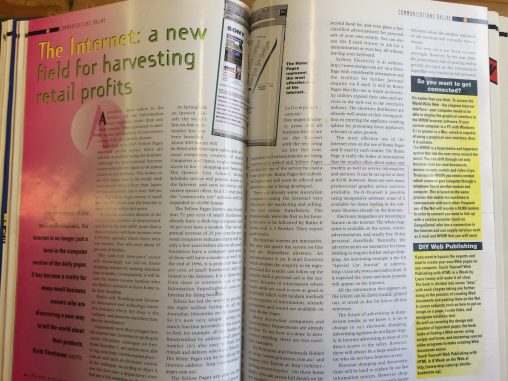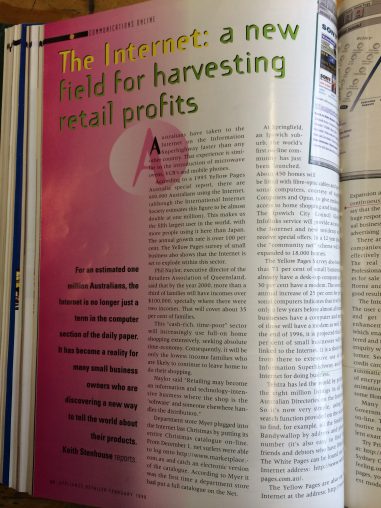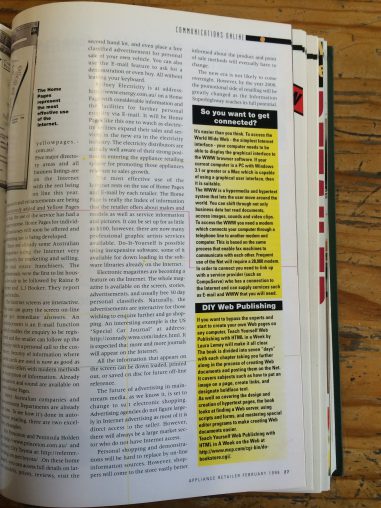Back in February 1996, Paul Keating was the Prime Minister, Wonderwall was top of the charts, Broken Arrow was top of the box office and the internet was still an arcane, inchoate web of mysticism for most Australians.
Appliance Retailer was only four issues old when, in its first edition of 1996, it published a guide to online retail and the future of the internet in Australia.
The article was written by ‘Queensland correspondent’ Keith Stenhouse, who does a pretty good job of describing the internet, considering how unusual the concept was for most people in the appliance industry, at that time. For some of our younger readers, who may have no concept of a world without the internet, back in 1996, I was in Year Nine at a Sydney high school that did not have a single computer connected to the Internet. It wasn’t until mid-1998 that I first used the internet, while at a friend’s place, and was amazed that I could access the US Billboard Hot 100 chart.
While Stenhouse is correct in predicting that, “The future of advertising in mainstream media, as we know it, is set to change to suit electronic shopping”, he was a little off in his belief that, “There will always be a large market sector who do not have Internet access”.
As part of its explanation, AR unironically wrote out website URLs in the body of this magazine text. We’ve included them in full — and many are still extant — but apologies if you click on several dead links.
Here, reprinted in full, is his article. I have included some photographs of the double-page spread at the bottom of this text:
THE INTERNET: A New Field for Harvesting Retail Profits
(Keith Stenhouse)
For an estimated one million Australians, the Internet is no longer just a term in the computer section of the daily paper. It has become a reality for many small business owners who are discovering a new way to tell the world about their products.
Australians have taken to the Internet on the information superhighway faster than any other country. That experience is similar to the interdiction of microwave ovens, VCR’s and mobile phones.
According to a 1995 Yellow Pages Australia special report, there are 600,000 Australians using the Internet, (Although the International Internet Society estimates this figure to be almost double at one million). This makes us the fifth largest user in the world, with more people using it here than Japan. The annual growth rate is over 100 per cent. The Yellow Pages survey of small business also shows that the Internet is set to explode within this sector.
Phil Naylor, executive director of the Retailers Association of Queensland, said that by the year 2000, more than a third of families will have incomes over $100,000, especially where there were two incomes. That will cover about 35 per cent of families.
This ‘cash-rich, time-poor’ sector will increasingly use full-on home shopping extensively, seeking absolute time-economy. Consequently, it will be only the lowest income families who are likely to continue to leave home to do their shopping.
Naylor said “Retailing may become an information and technology-intensive business where the shop is the ‘software’ and someone elsewhere handles the distribution.”
Department store Myer plugged into the Internet last Christmas by putting its entire Christmas catalogue on-line. From December 21, net surfers were able to log onto http://www.marketplace.com.au and catch an electronic version of the catalogue. According to Myer it was the first time a department store had put a full catalogue on the net.
At Springfield, an Ipswich suburb, the world’s first on-line community has just been launched. About 450 homes will be fitted with fibre-optic cables and personal computers, courtesy of Apple Computers and Optus, to give residents access to home shopping and banking. The Ipswich City Council Global Infolinks service will provide access to the Internet and new residents will receive special offers. In a 12 year plan, the ‘community net’ scheme will be expanded to 18,000 homes.
The Yellow Pages Survey also found that 71 per cent of small businesses already have a desk-top computer and 30 per cent have a modem. The overall annual increase of 25 per cent for personal computers indicates that it will be only a few years before almost all small businesses have a computer and most of those will have a modem as well. By the end of 1996, it is projected that 20 per cent of small businesses will be linked to the Internet. It is a short step from there to extensive use of the Information Superhighway and the Internet for doing business.
Telstra has led the world by putting the eight million listings in all the Australian Directories on the Internet. So it’s now very simple, using the search function provided on the screen to find, for example, all the Smiths in Bandywallop by address and phone number (it’s also easy to find lost friends and debtors who have flitted!). The White Pages can be found on the Internet address: http://www.whitepages.com.au.
The Yellow Pages are also on the Internet at the address: http://www.yellowpages.com.au.
Five major directory areas and all business listings are on the Internet with the rest being on line this year. Expansion and enhancements are being continuously added and Yellow Pages say that the use of the service has had a huge response. Home Pages for individual businesses will soon be offered and advertising use is being developed.
There are already some Australian companies using the Internet very effectively for marketing and selling. The real estate franchisers, The Professionals, were the first to list houses for sale to be followed by Raine & Horne and L.J. Hooker. They report good results.
The Internet screens are interactive. The user can query the screen on-line and get immediate answers. An enhancement is an E-mail function which enables the enquiry to be registered and the retailer can follow up the enquiry with a personal call to the customer. Security of information where credit cards are used is now as good as automatic tellers with modern methods of encryption of information. Already animation and sound are available on some Home Pages.
Many Australian companies and Government Departments are already on-line. To see how it’s done in automotive retailing, there are two excellent examples.
Try Princeton and Peninsula Holden at: http://www.princeton.com.au and Sydney City Toyota at: http://referrer.feeling.on.net/toyota. On these come pages, you can access full details on latest models, prices, review, visit the second hand lot, and even place a free classified advertisement for personal sale of your own vehicle. You can also use the E-mail feature to ask for a demonstration or even buy. All without leaving your keyboard.
Sydney Electricity is at address: http://www.energy.com.au on a Home Page with considerable information and the facilities for further personal enquiry via E-mail. It will be Home Pages like this one to watch as electricity utilities expand their sales and services in the new era in the electricity industry. The electricity distributors are already well aware of their strong position in entering the appliance retailing sphere for promoting those appliances relevant to sales growth.
The most effective use of the Internet rests on the use of Home Pages and E-mail by each retailer. The Home Page is really the Index of information that the retailer offers about makes and models as well as service information and pictures. It can be set up for as little as $100, however, there are now many professional graphic artists services available. Do-It-Yourself is possible using inexpensive software, some of it available for down loading in the software libraries already on the Internet.
Electronic magazines are becoming a feature on the Internet. The whole magazine is available on the screen, stories, advertisements, and usually free 30 day personal classifieds. Naturally, the advertisements are interactive for those wishing to enquire further and go shopping. An interesting example is the US ‘Special Car Journal’ at address: http://conrady.wwa.com/index.html. It is expected that more and more journals will appear on the Internet.
All the information that appears on the screen can be down loaded, printed out, or saved on disc for future off-line reference.
The future of advertising in mainstream media, as we know it, is set to change to suit electronic shopping. Advertising agencies to not figure largely in Internet advertising as most of it is direct access to the seller. However, there will always be a large market sector who do not have Internet access.
Personal shopping and demonstrations will be hard to replace by on-line information sources. However, shoppers will come to the store vastly better informed about the product and point of sale methods will eventually have to change.
The new era is not likely to come overnight. However, by the year 2000, the promotional side of retailing will be greatly changed as the Information Superhighway reaches its full potential.
So You Want to Get Connected?
(sidebar)
It’s easier than you think. To access the World Wide Web- the simplest Internet interface- your computer needs to be able to display the graphical interface to the WWW browser software. If your current computer is a PC with Windows 3.1 or greater or a Mac which is capable of using a graphical user interface, then it is suitable.
The WWW is a hypermedia and hypertext system that lets the user move around the world. You can shift through not only business data bud read documents, access images, sounds and video clips.
To access the WWW you need a modem which connects your computer through a telephone line to another modem and computer. This is based on the same process that enables fax machines to communicate with each other. Frequent use of the Net will require a 28,000 modem. In order to connect you need to link up with a service provide (such as CompuServe) who has a connection to the Internet and can supply services such as E-mail and WWW that you will need.
DIY Web Publishing
(sidebar)
If you want to bypass the experts and start to create your own Web pages on any computer, Teach Yourself Web Publishing with HTML in a Week by Laura Lemay will make it all clear.
The book is divided into seven ‘days’ with each chapter taking you further along in the process of creating Web documents and posting them on the Net. It covers subjects such as how to put an image on a page, create links, and designate boldface text.
As well as covering the design and creation of hypertext pages, the book looks at finding a Web server, using scripts and forms, and mastering special editor programs to make creating Web documents easier.
Teach Yourself Web Publishing with HTML in a Week on the Web at http://www.mcp.com/cgi-bin/dobookstore.cgi/.



Andrew Jackson contributed to this posting.

